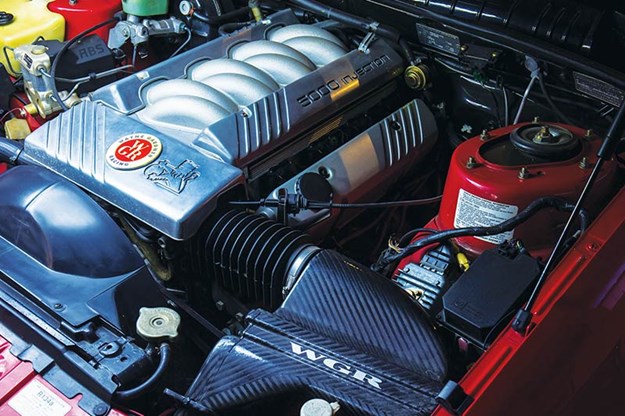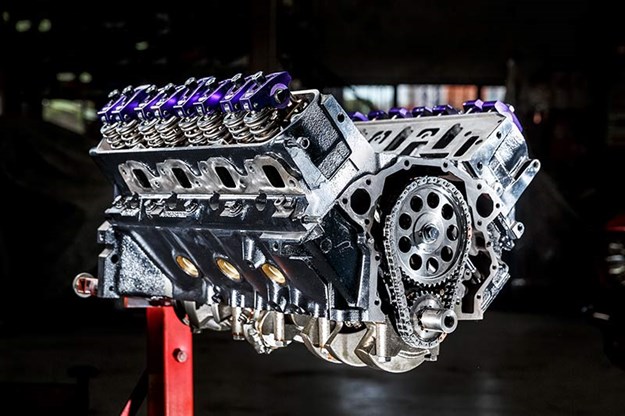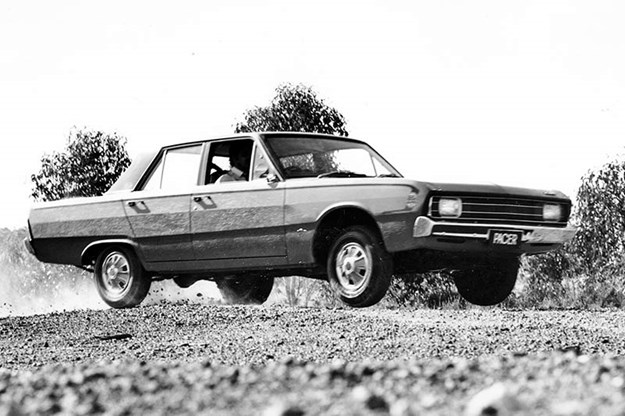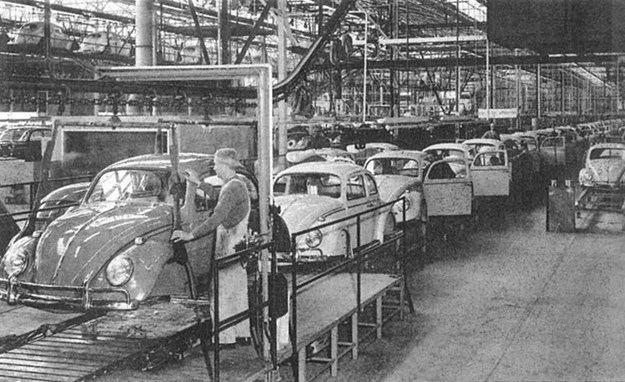Wheels, drivers and V8 mods - Mick's Workshop 444



|
Dodgy wheels, good tools and Holden 304 hot-up
MICK'S WORKSHOP
Righto, ladies, gentlemen, bald-headed babies, and tax-dodgers, let’s talk wheels.
I’ve been sent a very tidy old Valiant to work on and, while it’s beautiful, once I took a close look I would not ride in it. Not if I planned to stay healthy, which I do.
The reason was it had a beautiful set of replica Minilite wheels which were ready to come off the first time someone threw it into a corner with any enthusiasm. They simply didn’t have enough thread on the studs for a proper tapered set of nuts, and the conventional nuts that had been used were chewing into the alloy surrounding the stud holes. While they might have felt tight when fitted, they weren’t staying that way. Literally a recipe for disaster.
That conical shape on the end of a wheel nut is known as a Morse taper, and that’s what locks in the wheel, not the thread. You need correct engagement of that taper.
It wasn’t the owner’s fault. He wasn’t to know. Whoever sold and fitted the wheels should have known better. The wheels might have had the correct stud pattern, but the offsets were wrong and the studs that were in place were left way too short.
In this case we were able to correct the problem with new studs custom-made from longer donor items. That’s pretty standard – you buy fresh studs that are longer than you need, then trim them down to the right length. It’s laborious, but it’s something you just don’t mess with.
We can now send him away, comfortable in the knowledge the car won’t try to toss a wheel.

Electric Tools
We have had a few people ask us to talk about some of the tools we depend on, including electric gadgets. Last month we tackled hoists and the short version of that was we reckon a standard four-poster from a reputable mob such as Tufflift is the way to go.
Next, electric drivers. While I may be an old school mechanic, that doesn’t mean I don’t enjoy a good labour-saving device. The one that gets the biggest work-out is a little cordless screwdriver which can also be used for smaller nuts and bolts. One of its most critical features is that it’s small, so it can get into crowded engine bays.
Mine is a Snap-On, and these things aren’t cheap, but I seem to get my money’s worth out of them. I also keep a bigger cordless impact driver, which I’m much more choosy about using. It’s useful for shocking loose something. While I’ve developed a really good feel for air tools over time, electric tools don’t give you the same warning signals when things are getting out of hand. So it pays to be careful.
Here's my tip
Gas it, now

Warm weather is just around the corner, so if you were contemplating getting that air-con regassed, do it now before the rush starts, and while the workshops are still hungry for work.
LETTERS
Nice 304

No stroking required for more hp
G’day Mick. I have a 1993 VR Calais with the injected 5 litre V8. I’m looking for some sensible but worthwhile performance enhancements for the engine. I read in your publication a little while ago about the Wayne Gardner VR Commodore he was producing and it gave a bit of an insight into what was going into those motors.
The essence of it was that the performance he gained from the engine build produced a very good free spinning motor with good power and without going the stroker route to do it.
My intentions would be along those lines with attention to breathing, spark and fuel delivery improvements. I have also considered going the LS path but it seems to be a fairly involved process...not that it can’t be done. I have in mind originality and I really like the injected Holden V8...I think it’s a very nice engine.
I’d really like your opinions on what cam, crank, rods, pistons, rocker gear, valves etc would give me a punchy but totally manageable and reliable power plant and importantly an engine that will spin to good revs without any damage taking place. I’ d assume a careful balance of all the internals would help a lot.
Looking forward to your considered advice.
Simon
A LOT IS going to depend on how deep you want to dig into that wallet. There’s no question a nicely balanced engine will deliver results just on its own. It swallows a fair bit of time, but is worth the effort if you’re pulling the engine apart.
If we look at it from another direction, bang for buck, I would look at an SS cam, larger injectors, and more free-flowing headers. That should be tied together with a revision of your ECU tune, and a brand such as Memcal can give you an off-the-shelf solution.
If you go down the route of fresh pistons – and there are a lot of good options out there – then you should also consider working the heads. There I’d be looking for a port and polish as a starting point. If you go the whole hog, you might toy with alterations to the valve train, including shaft rather than pedestal-mounted rockers to enable some more freedom with revs.
If you’re looking for a one-stop shop that can supply an integrated set of gear for your build, you could do worse than have a chat with Rocket Industries.
Another option – and I’ll just throw this out there – is keep an eye out for an existing project engine that’s already underway. We found one for Ed Guido’s VK build. It was a 355 (pictured below) with Scat bottom end and pistons, balanced, with lots of other good gear such as Crow cam, for about two-thirds of what it would have cost to build from scratch. Ask around and you’ll find there is always someone out there who has run out of time, patience, money or has discovered the opposite sex, who’s happy to offload a perfectly good project!
Let us know how you get on, as we’d love to hear about it and we’ll be happy to offer advice along the way as you narrow down the options.
Urban Legends

Re the letter last issue from Shaun Jones on the three-door Hyundai Veloster, and the "urban legend" of a three-door LJ Torana, I just want to confirm to you that I had heard of the story of this three-door Torana way back in the 1970s. And it could’ve even been an LC Torana!
Unfortunately I have no proof of the veracity of it, but just offer confirmation of the existence of the story way back then.
Further to your story on the Charger, where you referenced the two "ute mules" which Chrysler used in developing the Chargers, and your request for "oddballs", I offer you a VG Pacer 340 V8.
At the end of 1972, when a good mate and fellow Chrysler fan was home in Port Macquarie and working at a service station during his uni holidays, a VG Pacer - bear in mind not much more than 12-18 months old - came in for fuel.
My mate’s interest in it was such that the driver told him that it was a Chrysler test vehicle, and showed him the 340 in the nose.
I can vouch for my mate’s veracity, but whether the driver and his off-sider were truthful, I know not.
I have tried variously without success to confirm the claim.
Thanks for all your excellent stories and articles.
Ross Krippner
RIGHT, WELL, that should put the proverbial cat among the Mopar fans. What does the brains trust think?
This is one of those stories that’s entirely believable, as the good folk back in South Oz would have toyed with all sorts of interesting ideas over time. And I guess there was always the opportunity for an enterprising engineer to build up something special on the weekend. While the LA 340 wasn’t an Australian market engine for VG series, it was certainly available in the USA.
I slotted one into a VC Regal I owned many moons ago and still miss it.
400 Hornet?

A V8 would certainly have added more pace to the Valiant Pacer
Hey Mick, don’t know if someone is having a lend of you or not, but the bit about the bloke restoring an old Monaro with a 400 Hornet engine?
There is no such thing as a Rambler Hornet 400. The Biggest engine we got in our Rambler Hornet was a 232 six.
In North America, Rambler wasn’t used in that period – they were AMC Hornets.
The largest engine was the AMC 360 (nothing to do with Chrysler), which were a nice passenger car engine, but be careful if you wanted to rev it, with cast-iron con rods and all...
AMC did have a nice 401 engine that appeared in 71-72, generally in the bigger cars, not a compact Hornet.
Who in the world would put a damn AMC engine in a GM Holden, when there are like about a million different sorts of Holden and GM engines?
A 308 (stroker) or any one of the 100s of different sorts of Chevy V8s would be a much cheaper option.
There are no stroker kits for the 401 AMC and first you have to find a 401...they are rare as hen’s teeth and chased by AMCers in the US.
I reckon the bloke was pulling your leg.
Certainly a very good way to lower the value of a nice old Monaro.
Marco
A 401 IT IS, then. As you say, the 401 was never fitted standard to a Hornet, but that didn’t stop people giving it a go, including one famous (infamous?) cannonball crew who cobbled together a 1972 Hornet with a 401 and long range tanks. They came 13th, after crossing the USA at an average of 113km/h.
By the way, didn’t the local Hornets also get the 258ci six?
I know what you’re saying regarding keeping the Monaro in the GM family, but by the time we’re finished, there won’t be much original car left, certainly not under the skin. Anyway, as it runs out the engine is a 400 GM that was previously in a Hornet..it’s a strange world, isn’t it?
GM or non-GM issues aside, you should see the custom front end we’re in the throes of installing! Maybe next issue…
Too much tech
Thanks for the great mag. I fully concur with Ed Guido’s article on the proliferation of electronic gadgetry being inflicted on us in new cars. Due to a serious lower back problem I’ve had to upsize to our first SUV, a new Hyundai Tucson and am feeling less than enamoured with the car.
His comment on lane departure cameras is spot on. When I purchased the vehicle I was unaware of its foibles. I can live with a discreet warning noise but the tugging of the steering wheel without any input from me, in my opinion is downright dangerous and caught me by surprise the first time it activated. And it’s not fool-proof, either. Crossing multiple lane markings on big intersections sent it into a frenzy of wheel pulling. I have disengaged it completely. But it doesn’t end there!
Two weeks after buying it in February, driving down the M1, a stone hit the top left hand corner of the windscreen and a crack started immediately. Within 10 minutes the crack grew.
Hyundai advised me, as the camera is in the windscreen, a new replacement screen would cost $1840 to replace and recalibrate the camera.
And guess what again, there were only four windscreens in the country, all in Sydney, and it took three days to get one to the Gold Coast.
With supply problems due to Covid I could have missed out and waited maybe weeks or longer for it to be fixed. I rack up more than 20k a year and have replaced many screens over more than 50 years. Whatever happened to the non-genuine $300 replacement?
The windscreen fitter advised that some windscreens for European machinery can cost in excess of $4000 and that doesn’t include recalibration which can cost an extra $600 or so.
Why can’t the camera be fitted either in the grill or in a bubble on the roof?
Don’t get me wrong I’m all in favour of active safety features such as airbags, ABS brakes rear camera etcetera, but the only additional ones I need are continuous tyre pressure monitoring, blind spot warning and front parking sensors.
Mark Lamerton
IF YOU WANT to see Ed Guido have a good old-fashioned rant, just mention lane departure warnings.
We now have a car that’s run by some sort of electronic committee. I turn the wheel to change lanes. That was put to the committee and it’s turned down. Even your right foot is no longer connected to the engine – that has to go through the committee!
What happened to the good old days when you told the car what to do?
TRIVIAL PURSUIT
Colour codes

Ever wondered why 1970s Aussie-assembled Volvos and Beetles seem to have similar colours? They were actually the same and run through a shared paint shop in Clayton. All that changed between brands was the names of the colours, so Light Blue in a Volvo was Flipper Blue in a VW.
(From Dave Morley’s excellent book, Great Aussie Car Fails, published by Hardie Grant.)
Got a problem?
Want some advice on a build or a potential car purchase. Heck we’ll even tackle long distance diagnosis. Drop us a line at uniquecars@primecreative.com.au
From Unique Cars #444, Sep 2020
Unique Cars magazine Value Guides
Sell your car for free right here
Get your monthly fix of news, reviews and stories on the greatest cars and minds in the automotive world.
Subscribe

.jpg)












